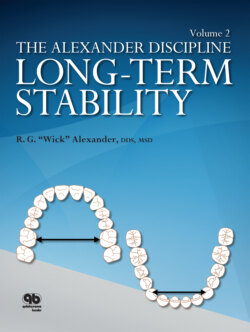Читать книгу The 20 Principles of the Alexander Discipline, Volume 2 - R.G. "Wick" Alexander - Страница 11
На сайте Литреса книга снята с продажи.
Six Guidelines to Building Facial Harmony and Stability
Оглавление1 Surrounding tissuesPeriodontal healthTMJ
2 Anterior torque controlIMPANasolabial angleInterincisal angle
3 Skeletal controlVerticalSagittal
4 Transverse controlMandibular 3 × 3 widthMaxillary 6 × 6 widthArch form
5 OcclusionRoot positionLeveled mandibular archInterproximal reductionFinal occlusion
6 Soft tissue profile and smile
Presented with most guidelines are:
Evidence: As often as possible, research from graduate orthodontic students using the author’s diagnostic records directly addresses the question related to the specific subject.
Mechanics: Throughout my 45-year practice of treating more than 15,000 patients with full orthodontic appliances, specific mechanical techniques have been created to address specific issues. These mechanics are explained and demonstrated. More detailed explanations can be found in volume one of this series.
Exceptions: Someone once said, “There is an exception to every rule.” In orthodontics, this statement is partially true; I attempt to distinguish the differences.
During a presentation on posttreatment changes during and after retention, Dr Asai (Crazyhorse) Yasuhiko, one of Japan’s outstanding orthodontists, said the following: “It has been said that the biggest cause of relapse is inappropriate treatment, above all other factors causing posttreatment changes, such as growth, jaw position, function, and habits. This is a matter of common sense.”12
